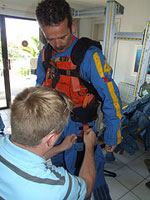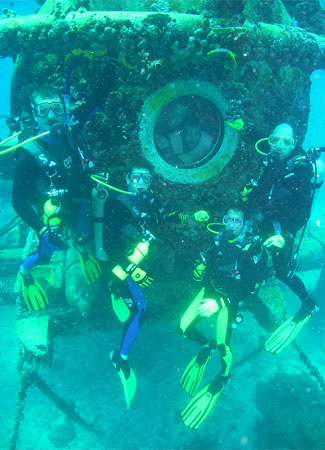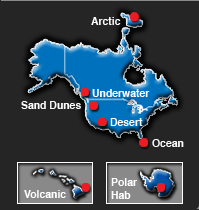Be sure to check out the photos on FLICKR:
http://www.flickr.com/photos/40054892@N06/
![]()
Sea Hear
Living under the ocean, my eyes keep turning to the windows. The round ports glow with translucent pastel blue fog, a parade of fish flying endlessly through. I can’t help thinking I’m somehow on the wrong side of an aquarium.
Even more different, though, is what we hear. A loud constant crashing of sounds with the volume going up and down, as if someone kept turning the control knob. That’s because it’s stormy overhead, and as the waves pass over the pressure goes up and down and our ears nearly pop. Every time I swallow it gets louder and then quieter.
The Aquarius habitat regularly burps, a low deep gurgling rumble when the new fresh air pushes the old out under the edges of our Wet Porch. We send a huge roaring white bubble to the surface. Inside, the fans make a constant whirring hum, blowing clean oxygen into every corner and filtering the carbon dioxide.
There are 6 radios and phones, all ringing and echoing in metallic, distant voices. Andrew’s spacewalking voice comes tinnily through a small speaker. The technical suit-up conversation in the Wet Porch snaps with equipment clanking and feedback, as Nate gets Tom’s helmet safely attached.
And somehow it’s like Darth Vader is everywhere, his deep, machine breath going forever in and out. It’s actually from the spacewalkers, as their voices are mixed with every inhale and exhale, a simple reminder of how hard they are working.
The smallest sound is from the fish themselves, as they nibble and bite at the green-brown growth on the outside. Their beaks must be strong, since they make such a harsh and purposeful scratching noise. The bits they spit out fall past the window, a shower of lumpy wet dust.
My ears are under assault, but my eyes are drawn to the sea.
Chris (Cmdr. Chris Hadfield)




 We have teams testing and training next generation vehicles and life systems in the arctic deserts and lakes of Canada; deep beneath the surface of the ocean near the Florida Keys; on the side of a dormant volcano in Hawaii; and in the dry, dusty deserts of Arizona.
We have teams testing and training next generation vehicles and life systems in the arctic deserts and lakes of Canada; deep beneath the surface of the ocean near the Florida Keys; on the side of a dormant volcano in Hawaii; and in the dry, dusty deserts of Arizona.